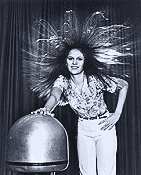Static Electricity and the Triboelectric Series |
||||
Girl's hair standing on end while she has her hand on a Van de Graff generator, which transfers electrons to the metal sphere via a rubber belt. The phenomenon of triboelectricity, or the generation of static electricity through friction, has been known to humans for thousands of years. It is one of the earliest observed electrical phenomena, and its discovery predates recorded history. History Ancient civilizations, including the Greeks and Egyptians, were aware of the properties of certain materials to become electrically charged when rubbed together. They used materials like amber (known as "elektron" in Greek, which is the origin of the word "electricity") to create small sparks or to attract lightweight objects such as feathers. The Greek philosopher Thales of Miletus (circa 624–546 BCE) is often credited with some of the earliest recorded observations of amber's electrical properties. The famous experiment involving rubbing amber with fur, which demonstrates triboelectric charging, was described by the Roman author Pliny the Elder in his work "Naturalis Historia" around 77 CE. Pliny noted that amber could attract small particles when rubbed, a phenomenon we now understand as static electricity. Over time, further experimentation and observations led to the understanding that various materials exhibited different tendencies to gain or lose electrons during friction. This knowledge eventually led to the development of the triboelectric series, which ranks materials based on their relative triboelectric properties. In summary, triboelectricity was discovered and observed by ancient civilizations, and its understanding evolved over centuries through experimentation and documentation of the behavior of various materials when subjected to friction. It laid the foundation for our modern understanding of electricity and electrostatics. Affinity Values Triboelectric affinity value, sometimes referred to as the triboelectric series value, is a measure that quantifies the tendency of a material to become electrically charged through triboelectric charging. This value represents the material's relative affinity for gaining or losing electrons when it comes into contact with other materials. The triboelectric affinity value is typically expressed in terms of a numerical scale, with positive values indicating a higher tendency to become positively charged (electron-deficient), and negative values indicating a higher tendency to become negatively charged (electron-rich) when in contact with materials higher up the triboelectric series. It's important to note that the specific numerical values for triboelectric affinity can vary between sources and may be used in various scientific and engineering applications. The values are based on experimental observations and may not be universally standardized. Here is a simplified example of a triboelectric series with some numerical affinity values: Material A (+5) Material B (+3) Material C (+1) Material D (0) Material E (-2) Material F (-4) In this example, Material A has the highest triboelectric affinity value (+5) and is more likely to become positively charged when in contact with other materials lower in the series. Conversely, Material F has the lowest triboelectric affinity value (-4) and is more likely to become negatively charged when in contact with other materials higher in the series. The specific values for materials in a triboelectric series can vary depending on factors like temperature, humidity, and the specific conditions of the experiment, so it's essential to use these values as a general guideline rather than precise measurements. Scientists and engineers often use such series to predict and control the behavior of materials in various applications involving static electricity, such as in sensors, generators, and industrial processes.
Posted September 29, 2023 |
||||
